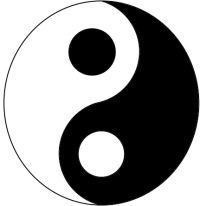|
|
 |
|
Yin Yang
Wikipedia
|
 |
|
 In Chinese concept, yin (陰 or 阴 in pinyin: yin1) and yang (陽 or 阳 yang2) are two opposing elements of the universe. They are not two poles like good and evil, however; they are relative. For example,
In Chinese concept, yin (陰 or 阴 in pinyin: yin1) and yang (陽 or 阳 yang2) are two opposing elements of the universe. They are not two poles like good and evil, however; they are relative. For example,
- Yin: associates with the dark Moon (facing away from Sun), represents feminine nature
- Yang: associates with the bright Sun, represents masculine nature
Yin and yang can also be used (in conjunction with other characters) to indicate various parts of the male and female anatomy.
A modern example:
- Yin: the traffic light on the freeway (the stillness)
- Yang: the traffic that flows past that traffic light (the vivaciousness)
Some Chinese, Korean and Japanese placenames that still exist are named in the following principle:
- Yin: the north side of the mountain, the south side of the river.
- Yang: the south side of the mountain, the north side of the river.
Although while yin dominates femininity and yang masculinity, within the body of either sex, there are still traces of both elements. As a result, an imbalance of the yin-yang ratio can cause illness. This is not to say that everyone should have exactly half of each; every individual needs to find this balance depending on their own constitution, climate, season, occupation and even emotional environment. And, if in perfect health, the individual should be able to adapt to any inevitable changes.
Together, the symbolic colours of yin and yang, black and white respectively, are combined into a circle that symbolizes Taoists (☯).
Because Taoism and all the ensuing philosophy is used to understand nothing less than all the complexities of the human body in (Chinese medicine) or the complexities of a human personality (Chinese astrology), nothing in the universe in completely yin or completely yang. It is a basic Taoist tenet, that there is always yin within yang, and yang within yin. This is symbolized in the Yin and Yang circle by the two smaller circles in either swoosh: black within white and white within black.
An example of the use of yin and yang in Chinese medicine is the liver, which is said to contain yang within yin. Because it stores blood, it has the yin qualities of holding, retention, and fullness. But because it also moves blood (qi), it has the yang qualities of movement, activity, warmth. Thus the liver is considered to be both a yin and a yang organ.
Another Taoist tenet is that one extreme will always turn into its opposite, so that extreme yang turns into yin and vice versa. This is symbolized in the yin-yang symbol by the shape of the outer swooshes, which appear to be moving, one into the other. This principle has been extended into the physical realm of the martial arts, where yang and yin can directly represent the limits of balance in different directions; up and down, left and right, forward and back; and the physical properties of full and empty, hard and soft, active and receptive, etc. Over the centuries, the study of the interplay between these principles has led to the formulation and refinement of many different systems of self-defense across East Asia.
| yin | yang
|
|---|
| female | male
| | moon | sun
| | black | white
| | darkness | light
| | fat | muscle, bone
|
This article is licensed under the
GNU Free Documentation License. It uses material from the
Wikipedia article "Yin Yang".
 |
Last Modified: 2004-02-16 |
|

 In Chinese concept, yin (陰 or 阴 in pinyin: yin1) and yang (陽 or 阳 yang2) are two opposing elements of the universe. They are not two poles like good and evil, however; they are relative. For example,
In Chinese concept, yin (陰 or 阴 in pinyin: yin1) and yang (陽 or 阳 yang2) are two opposing elements of the universe. They are not two poles like good and evil, however; they are relative. For example,